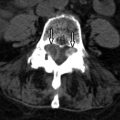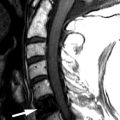Clinical Presentation
The patient is a 32-year-old man with a history of low back and left hip pain that developed 9 months prior and diffuse back pain and back throbbing over the past 3 months. The patient has recently developed lower extremity numbness and burning in the feet and occasionally experiences a sharp radiating pain down the spine (L’Hermitte’s sign). He has been unable to walk any distance and experiences occasional urinary and fecal urgency. He reports one episode of urinary incontinence. Physical examination reveals diminished sensation to pinprick in the lower trunk and below. He has moderately reduced strength in the hip flexors and mildly reduced strength in the feet dorsiflexors. The clinical findings are those of myelopathy with a sensory level in the mid to lower thoracic region.
Imaging Presentation
Magnetic resonance (MR) imaging was obtained and revealed a lobulated, dumbbell-shaped, 4 cm in maximal dimension mass located at the T11 level. The mass has a large intradural component and smaller extradural component extending into and enlarging the right T11-12 neural foramen, consistent with nerve sheath tumor (schwannoma or neurofibroma) ( Figs. 65-1 to 65-4 ) .




Discussion
A schwannoma is a nerve sheath tumor arising from Schwann cells in the nerve sheath. Sometimes referred to as neurilemmoma or neurinoma , a schwannoma is the most common intradural-extramedullary tumor originating within the thecal sac (meningioma is the second most common intradural-extramedullary tumor) ( Fig. 65-5 ) . Approximately 75% of spinal schwannomas arise intradurally; 15% of spinal schwannomas are located in both the intradural and extradural compartments. The majority of other spinal schwannomas are entirely extradural, located in the paraspinal region ( Fig. 65-6 ) . Rarely, intradural schwannomas occur that have an intramedullary component.


Those schwannomas with intradural and extradural components characteristically have a dumbbell configuration. Small to medium-sized schwannomas are commonly discovered as incidental findings within the thecal sac arising from the cauda equina on routine MR imaging ( Figs. 65-5 , 65-7, and 65-8 ) . Intradural nerve sheath tumors can be lobulated (see Figs. 65-7 and 65-8 ) or spherical in configuration ( Fig. 65-9 ) . So called giant schwannomas may also occur, which are large tumors that can extend for a variable distance into the paraspinal soft tissues ( Fig. 65-10 ) .




Schwannoma is the second most common nerve sheath tumor, the neurofibroma being the most common nerve sheath tumor. Far less common nerve sheath tumors include ganglioneuromas and malignant nerve sheath tumors. Schwannomas arise in the nerve sheath eccentric to the adjacent nerve and are slowly growing tumors. These tumors manifest as isolated masses or as multiple masses anywhere along the spinal axis. Schwannomas are usually isolated lesions except when associated with neurofibromatosis type-2 (NF-2). Most patients with a schwannoma have the sporadic form of the disease; 50% or more of the patients with the more common (sporadic) form have gene mutations that inactivate a portion of chromosome 22 . However, the patients with the sporadic form do not have the other manifestations of neurofibromatosis type 2 (NF-2).
Most schwannomas, solitary or multiple, occur sporadically. The presence of multiple schwannomas does not necessarily mean the patient has NF-2, although multiple schwannomas almost always occur in patients with NF-2. Neurofibromatosis type 2 is an autosomal dominant condition associated with mutations in chromosome 22q (long arm) that occurs in approximately 1 in 30,000 people. Patients with NF-2 usually have multiple schwannomas either intracranially, in the spinal canal, or neural foramina, along with other tumors, including meningiomas and ependymomas, which may occur in the spine or intracranially in NF-2 patients ( Figs. 65-11 to 65-14 ) . The presence of bilateral cranial nerve VIII schwannomas is pathognomonic of NF-2 (see Fig. 65-11 ), but cranial nerve VIII schwannomas may be absent in patients with NF-2. The intradural and paraspinal nerve sheath tumors in NF-2 are usually schwannomas, but some patients with this condition have both nerve sheath schwannomas and neurofibromas. However, the majority of nerve sheath tumors in patients with neurofibromatosis type 1 (NF-1, von Recklinghausen disease) are neurofibromas or plexiform neurofibromas. However, schwannomas can also occur in patients with NF-1.



Stay updated, free articles. Join our Telegram channel

Full access? Get Clinical Tree








